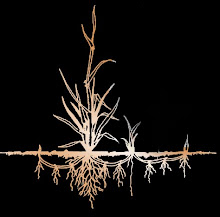Epistemic Companions: Art and the Sacred By Danielle Boutet
http://www.metanexus.net/magazine/tabid/68/id/10030/Default.aspx
The Artistic “Revelation”
For me, a lifetime of creative work has brought up the question of “artistic thinking,” i.e. art’s unique way of thinking and knowing. Informed by transdisciplinary studies and conversations, I have often posed the question in these terms: what does one know through art? Is there something, unknown through science or rational inquiry that can be known only through art? What does art contribute to knowledge, alongside other modes of knowing such as philosophy, psychology, theology, anthropology, or the natural sciences?
We are used to thinking of art as a form of expression, more than a way of knowing. Yet if artists do, indeed, express what they know about the world and about themselves in their work, it is most often the work—through the experience and the process of its making—that informs the artist about what it says. Many artists will agree that artistic creation is not so much a work of expression as a work of revelation. “What I do tells me what I am looking for,” says Soulages:5 meaning is revealed in the work, which the artist has indeed worked to “ex-press”—but not in the sense of “self-expression,” rather in the sense of “pressing out,” of “making appear” or “making emerge” from matter. The successful artwork surprises the artist, who is often the first to be taken by its meaning.
But how is this possible?
How can the artwork make visible (audible or perceptible) meanings or layers that its author does not necessarily see prior to making the work? And if what is made visible belongs to the world and to what connects the artist to it, what does this say about the world? What is this world that makes itself known through art?6
Obviously, something of the world is revealed through creative practice and aesthetic contemplation. Paul Klee states,
I. Widening the Definition of Knowledge
Art in the Definition of Knowledge
To ask what is known through art requires a wider, more general definition of knowledge; one in which art would be an epistemology as essential and effective as science and advanced forms of philosophy. Yet in order to integrate art among the other fields of knowledge, we need to assume that knowledge could be at once scientific and non-scientific, sure and uncertain, objective and subjective.
READ ON ... http://www.metanexus.net/magazine/tabid/68/id/10030/Default.aspx
http://www.metanexus.net/magazine/tabid/68/id/10030/Default.aspx
The Artistic “Revelation”
For me, a lifetime of creative work has brought up the question of “artistic thinking,” i.e. art’s unique way of thinking and knowing. Informed by transdisciplinary studies and conversations, I have often posed the question in these terms: what does one know through art? Is there something, unknown through science or rational inquiry that can be known only through art? What does art contribute to knowledge, alongside other modes of knowing such as philosophy, psychology, theology, anthropology, or the natural sciences?
We are used to thinking of art as a form of expression, more than a way of knowing. Yet if artists do, indeed, express what they know about the world and about themselves in their work, it is most often the work—through the experience and the process of its making—that informs the artist about what it says. Many artists will agree that artistic creation is not so much a work of expression as a work of revelation. “What I do tells me what I am looking for,” says Soulages:5 meaning is revealed in the work, which the artist has indeed worked to “ex-press”—but not in the sense of “self-expression,” rather in the sense of “pressing out,” of “making appear” or “making emerge” from matter. The successful artwork surprises the artist, who is often the first to be taken by its meaning.
But how is this possible?
How can the artwork make visible (audible or perceptible) meanings or layers that its author does not necessarily see prior to making the work? And if what is made visible belongs to the world and to what connects the artist to it, what does this say about the world? What is this world that makes itself known through art?6
Obviously, something of the world is revealed through creative practice and aesthetic contemplation. Paul Klee states,
“Art does not reproduce the visible, rather it makes visible.”7 Art makes visible different dimensions or a revelation different from what science and philosophy, for instance, allow us to know.
I. Widening the Definition of Knowledge
Art in the Definition of Knowledge
To ask what is known through art requires a wider, more general definition of knowledge; one in which art would be an epistemology as essential and effective as science and advanced forms of philosophy. Yet in order to integrate art among the other fields of knowledge, we need to assume that knowledge could be at once scientific and non-scientific, sure and uncertain, objective and subjective.
READ ON ... http://www.metanexus.net/magazine/tabid/68/id/10030/Default.aspx















